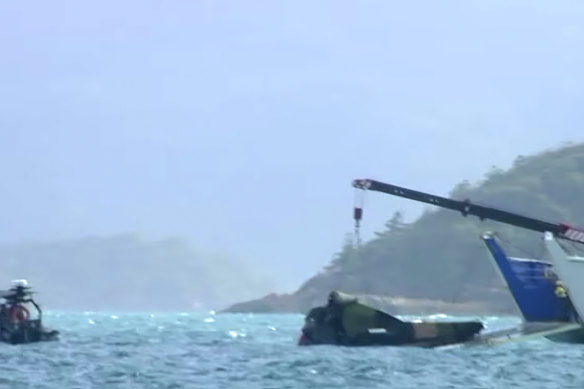This was published 1 year ago
Opinion
In preparing for future warfare, there are no risk-free approaches
Mick Ryan
Military leader and strategistOn Saturday morning, we awoke to the terrible news of the crash of an Australian Army helicopter during a night training exercise in northern Queensland. While participating in Exercise Talisman Sabre 2023, the crew of four ditched in the waters off Lindeman Island. This is a tragedy for their families, friends, their unit and the Australian Army.
The accident highlights the demands of military training under modern conditions. The war in Ukraine has, again, shown why demanding peacetime training is an essential foundation for success on the modern battlefield. Training activities provide the scenarios, under conditions of high perceived threat, that replicate the ground, air, maritime, electromagnetic and cyber hazards that our service personnel must be prepared for.

Taipan wreckage was found off the Queensland coast following significant search efforts to locate the crashed helicopter and its crew. Credit: ABC News
The biggest military training activity for the Australian Defence Force right now is Exercise Talisman Sabre. While originally a US-Australia only exercise, it has evolved into a very significant multinational training activity. These major training activities provide a canvas for the development of military capabilities, with four standing out.
An important outcome of exercises like Talisman Sabre is that they better integrate the three services of the Australian Defence Force, as well as the Australian forces with their friends and allies. There is an imperative in modern warfare to ensure armies, navies, air, space and cyber forces can effectively integrate their operations in the physical and information domains.
The Chinese, who have implemented a concept called Systems Destruction Warfare, aim to break down allied integration because they understand just how powerful the collaboration of different domains and different allies can be. Talisman Sabre hones the ability of commanders, planning staffs, and operational units on the ground, in the air, on and under the sea and in cyberspace to work and fight together. History has demonstrated the power of alliances. There is every prospect of our allies and friends calling on us for support again in the future.
A second imperative for activities like Talisman Sabre is that they act as rehearsals for the many enabling activities that underpin the conduct of combat operations. The lead up of major exercises features the large-scale logistic movement of equipment, munitions, fuel and people across our region – and from around the world. This provides practice in the all-important art and science of operational and strategic logistics with some degree of realism. As the Russians have learnt in Ukraine, neglecting this aspect of the military profession can have profoundly bad outcomes on the battlefield. Therefore, Talisman Sabre is a crucial opportunity to rehearse the logistics, as well as strategic communications architecture and integration with civilian contractors, necessary for large scale military operations across the Indo-Pacific.
A third outcome for major exercises is providing strategic messaging to potential adversaries. It tells authoritarian regimes that if they do want to pick a fight, they will be fighting against a team and not individual nations. This is a powerful message to those who might wish to risk more aggressive military adventures in our region in the coming years. And despite the paucity of information from the Australian Department of Defence on major activities like this, enough of the other participating nations are undertaking their own strategic influence campaigns through the media to ensure that the Chinese and others get the message.
A final imperative for Exercise Talisman Sabre is that it is an opportunity to learn. Such major joint and combined (international) activities are conducted only every second year in our nation. The planning and execution of such exercises ensures that our strategic leaders and planners, as well as operational commands and single service units all have the opportunity to conduct complex and demanding operations under conditions of high-technology, high intensity and high uncertainty. Evolved war-fighting ideas are tested, and new equipment – such as drones and long-range strike missiles – can be tested and integrated into Australian and coalition operations.
Talisman Sabre always ends with after-action reviews at many levels. A fine-tooth comb is pulled through every participating military organisation to see what worked, what didn’t and what capability gaps might have been unearthed. The action reviews and lessons-learnt reports that result are part of the organisational learning culture that is vital in modern military institutions.
Unfortunately, this will be of little comfort to the families and friends grieving their missing loved ones from the Army’s crashed helicopter. It will be difficult for some to reconcile the loss of these four Australian soldiers with the institutional gains provided by activities like Talisman Sabre. But, in preparing for future warfare, there are no risk-free approaches.
The amazing people of the Australian Defence Force turn up every day, understanding that they are subject to an unlimited liability in the service of their nation. Unfortunately, over the weekend, we learnt again the gut-wrenching reality of what that unlimited liability can mean.
Mick Ryan is a retired major general who served in the ADF for more than 35 years and was commander of the Australian Defence College. He is the author of War Transformed and an adjunct fellow at the Centre for Strategic and International Studies in Washington DC.
The Opinion newsletter is a weekly wrap of views that will challenge, champion and inform your own. Sign up here.